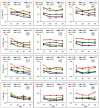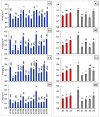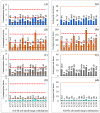Assessing the Capability of Chemical Ameliorants to Reduce the Bioavailability of Heavy Metals in Bulk Fly Ash Contaminated Soil
- PMID: 34834110
- PMCID: PMC8625082
- DOI: 10.3390/molecules26227019
Assessing the Capability of Chemical Ameliorants to Reduce the Bioavailability of Heavy Metals in Bulk Fly Ash Contaminated Soil
Abstract
In-situ rehabilitation of fly ash at dumping sites has rarely been addressed for crop production due to growth-related constraints, largely of heavy metal (HM) contamination in soils and crops. Current communication deals with a novel approach to identify a suitable management option for rejuvenating the contaminated soils. In this background, a 60-days incubation experiment was conducted with different fly ash-soil mixtures (50 + 50%, A1; 75 + 25%, A2; 100 + 0%, A3) along with four ameliorants, namely, lime (T1), sodium sulphide (T2), di-ammonium phosphate (T3), and humic acid (T4) at 30 ± 2 °C to assess the ability of different fly ash-soil-ameliorant mixtures in reducing bio-availability of HMs. Diethylenetriaminepentaacetic acid (DTPA)-extractable bio-available HM contents for lead (Pb), cadmium (Cd), nickel (Ni), and chromium (Cr) and their respective ratios to total HM contents under the influence of different treatments were estimated at 0, 15, 30, 45, and 60 days of incubation. Further, the eco-toxicological impact of different treatments on soil microbial properties was studied after 60 days of experimentation. A1T1 significantly recorded the lowest bio-availability of HMs (~49-233% lower) followed by A2T1 (~35-133%) among the treatments. The principal component analysis also confirmed the superiority of A1T1 and A2T1 in this regard. Further, A1T1 achieved low contamination factor and ecological risk with substantial microbial biomass carbon load and dehydrogenase activity. Thus, liming to fly ash-soil mixture at 50:50 may be considered as the best management option for ameliorating metal toxicity. This technology may guide thermal power plants to provide the necessary package of practices for the stakeholders to revive their contaminated lands for better environmental sustainability.
Keywords: ameliorants; biological indicator; environmental risk; metal bioavailability.
Conflict of interest statement
The authors declare no conflict of interest.
Figures






Similar articles
-
Screening of multi-metal tolerant plant growth promoting bacteria (PGPB) Stutzerimonas stutzeri WA4 and its assistance on phytoextraction of heavy metals (Cu, Ag and Pb).Int J Phytoremediation. 2025 Mar;27(4):505-525. doi: 10.1080/15226514.2024.2427384. Epub 2024 Nov 13. Int J Phytoremediation. 2025. PMID: 39535150
-
Biodiversity variability and metal accumulation strategies in plants spontaneously inhibiting fly ash lagoon, India.Environ Sci Pollut Res Int. 2017 Oct;24(29):22990-23005. doi: 10.1007/s11356-017-9930-4. Epub 2017 Aug 18. Environ Sci Pollut Res Int. 2017. PMID: 28819831
-
Assessment of fly ash-aided phytostabilisation of highly contaminated soils after an 8-year field trial Part 2. Influence on plants.Sci Total Environ. 2011 Oct 1;409(21):4504-10. doi: 10.1016/j.scitotenv.2011.07.047. Epub 2011 Aug 25. Sci Total Environ. 2011. PMID: 21871650
-
A critical review of the bioavailability and impacts of heavy metals in municipal solid waste composts compared to sewage sludge.Environ Int. 2009 Jan;35(1):142-56. doi: 10.1016/j.envint.2008.06.009. Epub 2008 Aug 8. Environ Int. 2009. PMID: 18691760 Review.
-
Recent trends in the use of fly ash for the adsorption of pollutants in contaminated wastewater and soils: Effects on soil quality and plant growth.Environ Sci Pollut Res Int. 2023 Dec;30(60):124427-124446. doi: 10.1007/s11356-022-19192-0. Epub 2022 Feb 27. Environ Sci Pollut Res Int. 2023. PMID: 35220542 Review.
References
-
- Belyaeva O.N., Haynes R.J. Comparison of the effects of conventional organic amendments and biochar on the chemical, physical and microbial properties of coal fly ash as a plant growth medium. Environ. Earth Sci. 2012;66:1987–1997. doi: 10.1007/s12665-011-1424-y. - DOI
-
- Tripathi R.C., Jha S.K., Ram L.C. Impact of heavy metals in Indian fly ashes on its application as soil ameliorant. Energy Sources Part A. 2016;38:2568–2574. doi: 10.1080/15567036.2015.1098744. - DOI
-
- Roy M., Roychowdhury R., Mukherjee P. Remediation of fly ash dumpsites through bioenergy crop plantation and generation: A review. Pedosphere. 2018;28:561–580. doi: 10.1016/S1002-0160(18)60033-5. - DOI
MeSH terms
Substances
LinkOut - more resources
Full Text Sources
Research Materials
Miscellaneous

